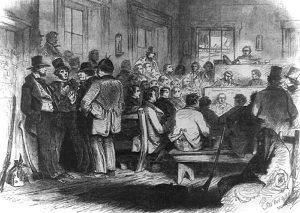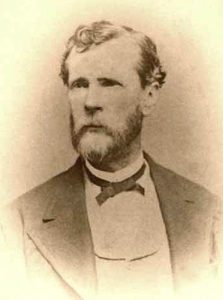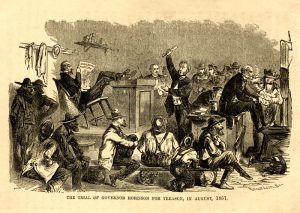The Constitutional Convention met at Topeka, Kansas, on October 23, 1855. It consisted of 47 delegates, including 18 Democrats, six Whigs, four republicans, two Free-Soilers, one Free-State man, and one Independent. The group elected James H. Lane as president and Samuel C. Smith as secretary.
Several of the delegates elected failed to attend the sessions of the convention. The following list of the men who framed the constitution was compiled from the manuscript records of the convention.
James M. Arthur, Thomas Bell, Frederick Brown, Orville C. Brown, Harrison Burson, Martin F. Conway, Rufus H. Crosby, A. Curtiss, George A. Cutler, Mark W. Delahay, David Dodge, J. S. Emery, D. M. Field, Matt France, J. K. Goodin, William Graham, William R. Griffith, W. H. Hicks, G. S. Hillyer, Cyrus K. Holliday, Morris Hunt, Amory Hunting, Robert Klotz, Richard Knight, John Landis, James H. Lane, S. N. Latta, Sanford McDaniel, Caleb May, Samuel Mewhinney, J. H. Nesbitt, M. J. Parrott, James Phenis, Josiah H. Pillsbury, Robert Riddle, W. Y. Roberts, Charles L. Robinson, James L. Sayle, Phillip C. Schuyler, George W. Smith, H. Smith, C. W. Stewart, J. C. Thompson, J. M. Turner, J. M. Tuton, N. Vandever, and J. A. Wakefield.
The convention completed its work on November 11, 1855, and provisions were made to submit the constitution to the people on December 15. In the event the constitution was ratified by popular vote at that time, the chairman of the Free State Executive Committee of the territory was directed to issue a proclamation ordering an election for state officers and members of the legislature on the third Monday of January 1856, and the legislature then chosen should meet on March 4, 1856.
In the December 15th election, Charles L. Robinson was elected governor, and the first Free-State Legislature met at Topeka on March 4, 1856. It elected ex-Governor Andrew Reeder (who had been appointed by President Franklin Pierce in June 1854) and James H. Lane as United States Senators.
The adoption of the constitution and the election of these state officers caused no small commotion in the political circles in Washington. The Bogus Legislature was still in existence and recognized by the Government at Washington as the only legislative authority in Kansas. The Territorial Governor appointed by the President was in full charge of the executive branch, with the United States Army at his command and the Federal judiciary submissive to his desires. The whole Topeka movement was regarded as treasonable. President Franklin Pierce, in a special message to Congress on January 24, 1856, said:
“No principle of public law, no practice or precedent under the Constitution of the United States, no rule of reason, right, or common sense, confers any such power as that now claimed by a mere party in the territory. In fact, what has been done is of a revolutionary character. It will become a treasonable insurrection if it reaches the length of organized resistance by force to the fundamental or any other federal law. ”
The Free-State Legislature adjourned on March 15, planning to meet again on July 4, 1856. A U.S. Congressional Committee, consisting of John Sherman, William A. Howard, and Mordecai Oliver, was appointed to inquire into the validity of the Bogus Legislature and the election of John Whitfield as governor. It arrived in Kansas on April 18, 1856, and the new “Free-State” officers sought the advice of Sherman and Howard, the Republican members. After discussing the whole situation, the Free-State men decided to stand by the Topeka Government against the Federal Authority, even by force if necessary.
His action forced him to leave the state on November 16 and hand in his resignation a month later. Secretary Stanton, acting governor, called a special session of the new Legislature. That body submitted the Lecompton Constitution to a vote of the people on January 4, 1858, with the following result. (Free-State men participating – pro-slavery men not participating.)
Against the constitution … 10,226
For the constitution with slavery … 138
For the constitution without slavery … 23
In the meantime, on December 24, 1857, a Democratic Convention held at Leavenworth utterly repudiated the Lecompton Constitution and petitioned Congress to reject it. John H. Stringfellow, ex-speaker of the Bogus Legislature, protested against the admission of Kansas under it on January 7, 1858, and said, “to do so will break down the Democratic Party at the North and seriously endanger the peace and interests of Missouri and Kansas if not of the whole Union. The slavery question in Kansas is settled against the South by immigration.” Governor Denver sent Rush Elmore to Washington with a confidential message to President James Buchanan not to present the Lecompton Constitution to Congress.
Others were trying to resurrect the Topeka Constitution, which President Buchanan denounced. On April 23, 1858, a compromise bill was introduced in Congress, passed both Houses on April 30, and was signed by Buchanan on May 4, 1858. Under it, the Lecompton Constitution was again submitted to a vote with the disastrous results of 1,788 for the proposition and 11,300 against it, a majority of 9,512. This was the last stand of the pro-slavery party in Kansas. Every election held in Kansas thereafter was carried either by the Free-State party or the republicans until 1882, when George W. Glick, a democrat, was elected governor.
But, shortly thereafter, Governor Charles Robinson and other Free-State leaders were indicted and arrested on the charge of treason. When the Free-State Legislature convened again on July 4, 1856, at Topeka, it was dispersed, at the mouth of loaded cannon, by Colonel Edwin Sumner under instructions of the President.
In the meantime, on June 15, the First National Republican Convention declared “that Kansas should be immediately admitted as a state of the Union, with her present free Constitution.” On June 25 Galusha A. Grow, of Pennsylvania introduced a bill in Congress to admit Kansas under the Topeka Constitution. This bill passed the House on July 3, 1856, by a vote of 99 to 97 but when it reached the Senate, they suggested that the people of Kansas should frame a new constitution. To this, the House refused to accede.
The Topeka Constitution epitomized the vital issue of the day. For nearly three years of bloody conflict, it was the rallying banner around which the Free-State men gathered. Under its folds, they stood in the Wakarusa War, the Sacking of Lawrence, the Battles of Hickory Point, Franklin, and Black Jack. The constitution was called by James H. Lane “the old blood-stained banner,” and so it was. It became the chief issue in the National Campaign of 1856, and as the story became known across the nation, it induced a wave of immigration to Kansas in the spring of 1857.
The Free-State Legislature met again in January 1857, and in June, the Legislature petitioned Congress to admit Kansas as a state, but it was denied. The Topeka movement was soon abandoned, and the Topeka Constitution became only “a scrap of paper.”
Compiled and edited by Kathy Alexander/Legends of Kansas, updated January 2023.
Also See:





